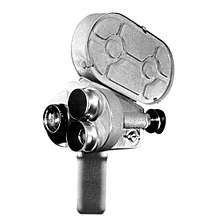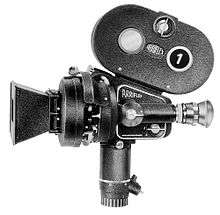Arriflex 35
The Arriflex 35, released by Arri in 1937, was the first reflex 35mm production motion picture camera.

Function
It was built around the spinning reflex twin-bladed "butterfly" mirror shutter designed by Erich Kästner, chief engineer at Arnold & Richter Cine Technik (ARRI), Arri Group, set at 45 degrees horizontally to the lens axis. This mirror reflex system was invented in 1931[1]. Modern standard models have a maximum shutter exposure opening of 165 degrees, (not 180 degrees as claimed in Arri manuals), the 35 IIC-BV model having a variable shutter. The mirror shutter allows the camera operator to see a viewfinder image equal to the recorded picture, without parallax, although there is noticeable image flicker in the viewfinder when the camera is running, caused by the two open exposure segments of the mirror shutter.
The camera utilizes a three lens turret with three aluminum Arri lens mounts (later 35 IIC/B with one stainless steel bayonet mount and two aluminum Arri mounts), and is capable of frame rates up to 80 frames per second with an accessory speed unit. Film magazines are for 200 ft or 400 ft loads. The DC motor is mounted downwards as a handgrip. Later flat base DC motor mount units were developed e.g. by the Cine 60 company, allowing the camera to have a lower profile, where the motor is mounted on the side of the camera body vertically upwards, allowing the camera to be mounted on standard tripod heads without a special head accommodating the handgrip motor, and providing a more compact profile for 'blimping'.
History
It is still used extensively in motion pictures for sequences without synchronous sound - "motor only sync" - and unique camera movement, e.g. on Steadicam. It was widely used with 200 ft loads (the smaller 200 ft magazine was in production at that time) as a 'battlefield camera' for the German Wehrmacht during World War II for collecting battlefront intelligence, (e.g. for analyzing weapons effectiveness), for training films and for use in propaganda cinema films.
Models
Arriflex 35
The Arriflex 35 was introduced as a handheld newsreel camera at the Leipzig Trade Fare in 1937. Although originally intended, the camera was just too late to be used at Leni Riefenstahl's Olympia I & II, therefore she shot on a Parvo camera.[2]. The US army captured some models and brought this camera to the US in the 1940s, where it served as a prototype for the almost identical Cineflex PH 330.[3]
Due to its importance during World war II footage, Arriflex 35 cameras were later used in the Nuremberg Trials.The original Arriflex 35 had three Arri standard mounts on a rotating turret. The viewfinder was a fixed tube on the camera door. It used both 200ft and 400ft magazines.
The first American feature film made using a captured Arriflex 35 was Dark Passage by Delmer Daves.
Arriflex 35 II

This model was released in 1946 and had one Arri standard mount and two Arri bayonet mounts. It could also load 500ft magazines and had a simple loop former, which made magazine changes quicker. ARRI began importing this camera to the US in 1947. The Arriflex 35 became a commonly used camera among New Wave filmmakers.
Arriflex 35 IIA
Introduced in 1953, the Arriflex 35 IIA featured a more robust steel film gate. It also used a 180° shutter instead of the double tailed butterfly shutter.
Arriflex 35 IIB
Released in 1960, this model had the first variable shutter, which could be adjusted with a tool through the lens mount.
Arriflex 35 IIC
The Arriflex 35 IIC was introduced in 1963, and had a larger ground glass and a movable viewfinder. It also allowed shooting anamorphic and seeing a desqueezed frame. It became a film production standard. It also used the then new PL mount.
Stanley Kubrick used the Arriflex 35 IIC on A Clockwork Orange.[4] The Pan Arri 35 IIC had one Panavision compatible lens mount and was used for Star Wars: A New Hope.[5]
Some Arriflex 35 IIC were used until the 2010s, for example in Savages in 2012. No other camera model has been used over such a long time.[6]
Arriflex 35 IIIC
The Arriflex 35 IIIC was released in 1982. It removed the turret and only featured a single PL mount, had a crystal sync handgrip motor with 12V and 5-50 fps, forward and reverse. This camera was not as successful as the Arriflex 35 IIC, and only a few models are still available.
References
- http://cinematechnic.com/resources/arri_35-2
- https://www.imdb.com/title/tt0030522/technical?ref_=tt_dt_spec
- Motion Picture Photography: A History, 1891-1960, p. 263
- https://www.imdb.com/title/tt0066921/technical?ref_=tt_dt_spec
- https://www.imdb.com/title/tt0076759/technical?ref_=tt_dt_spec
- https://shotonwhat.com/cameras/arriflex-35-iic-camera/page/2?view=more